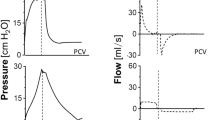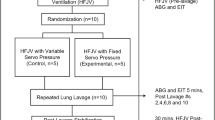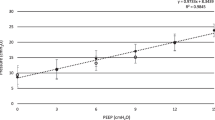Abstract
In adult respiratory distress syndrome (ARDS), whilst a great fraction of the lung is affected by the disease, some parts, still function normally creating a non-homogeneous distribution of lung pathology. This unequal distribution results in increased differences in time constants of different lung units (1–3). Conventional volume controlled ventilation (VCV) with positive end expiratory pressure (PEEP) with a standard inspiration/expiration (I/E) ratio of 1:2 may be inadequate to ventilate these affected lung units equally, as they tend to open later and close earlier compared to healthy alveoli due to high retractive forces. Prolonging the inspiration time of the respiratory cycle is suggested to overcome these time-constant inequalities within the ARDS lungs, ventilate all alveoli despite different retraction forces in the airways and improve the gas exchange (4,5). Furthermore, the application of pressure controlled inverse ratio ventilation (PC-IRV) is shown to provide better gas exchange with significantly lower peak inspiratory pressures (PIP) (4).
Access this chapter
Tax calculation will be finalised at checkout
Purchases are for personal use only
Preview
Unable to display preview. Download preview PDF.
Similar content being viewed by others
References
Gattinoni L., Pesenti A., Avalli L., Rossi F., and Bombina M., 1987, Pressure-volume curve of total respiratory system in acute respiratory failure: computed tomographic scan study, Am. Rev. Respir. Dis. 136:730–736.
Gattinoni L., Pesenti A., Bombino M., Baglioni S., Rivolta M., et al., 1988, Relationships between lung computed tomographic density, gas exchange, and PEEP in acute respiratory failure, Anesthesiology 69:824–832.
Dantzker D., 1982, Gas exchange in the adult respiratory distress syndrome, Clin. Chest Med. 3:57–67.
Lachmann B., Danzmann E., Haendly B., and Jonson B., 1982, Ventilator settings and gas exchange in respiratory distress syndrome, In: Prakash, O., (ed): Applied physiology in clinical respiratory care, Martinus Nijhoff Publishers, The Hague, 141–176.
Gattinoni L., Pesenti A., Caspani M.L., Pelizzola A., Mascheroni D., Marcolin R., Iapichino G., Langer M., Agostonia., Kolobow T., Melrose D.G., and Damia G., 1984, The role of total static lung compliance in the management of severe ARDS unresponsive to conventional treatment, Intensive Care Med. 10:121–126.
Greenfield L.J., Ebert P.A., and Benson D.W., 1964, Effect of positive pressure ventilation on surface tension properties of lung extracts, Anesthesiology 25:312–316.
Reynolds E.O.R., and Taghizadeh A., 1974, Improved prognosis of infants mechanically ventilated for hyaline membrane disease, Arch. Dis. Child. 49:505–515.
Lachmann B., Jonson B., Lindroth M., and Robertson B., 1982, Modes of artificial ventilation in severe respiratory distress syndrome. Lung function and morphology in rabits after washout of alveolar surfactant, Crit. Care Med. 10:724–732.
Mead J., and Collier C, 1959, Relation of volume history of lungs to respiratory mechanics in anaesthetized dogs, J. Appl. Physiol. 14:669–678.
Webb H.H., and Tierney D.F., 1974, Experimental pulmonary edema due to intermittent positive pressure ventilation with high inflation pressures. Protection by positive end-expiratory pressure, Am. Rev. Respir. Dis. 110:556–563.
Rossi A., Gottfried S.B., Higgs B.D., Zocchi L., Grassino A., and Milic-Emili J., 1985, Respiratory mechanics in mechanically ventilated patients with respiratory failure, J. Appl. Physiol. 58:184918–1858.
Broseghini C, Brandolese R., Poggi R., Polese G., Manzin E., Milic-Emili J., and Rossi A., 1988, Respiratory mechanics during the first day of mechanical ventilation in patients with pulmonary edema and chronic airway obstruction, Am. Rev. Respir. Dis. 138:355–361.
Huygen P.E., Gültuna I., Ince C, Zwart A., Bogaard J.M., Feenstra B.W., and Bruining H.A., 1993, Anew ventilation inhomogeneity index from multiple breath indicator gas wash-out tests in mechanically ventilated patients, Crit. Care Med. 21:1149–1158.
Lachmann B., Robertson B., and Vogel J., 1980, In-vivo lung lavage as an experimental model of the respiratory distress syndrome, Acta Anaesthesiol Scand. 24:231–236.
Hickling K.G., 1990, Ventilatory management of ARDS: can it affect the outcome? Intensive Care Med. 16:219–226.
Mead J., Takishima T., and Leith D., 1970, Stress distribution in lungs: a model of pulmonary elasticity, J. Appl. Physiol. 28:596–608.
Author information
Authors and Affiliations
Editor information
Editors and Affiliations
Rights and permissions
Copyright information
© 1996 Plenum Press New York
About this chapter
Cite this chapter
Kesecioğlu, J. et al. (1996). Assessment of Ventilation Inhomogeneity and Gas Exchange with Volume Controlled Ventilation and Pressure Regulated Volume Controlled Ventilation on Pigs with Surfactant Depleted Lungs. In: Ince, C., Kesecioglu, J., Telci, L., Akpir, K. (eds) Oxygen Transport to Tissue XVII. Advances in Experimental Medicine and Biology, vol 388. Springer, Boston, MA. https://doi.org/10.1007/978-1-4613-0333-6_69
Download citation
DOI: https://doi.org/10.1007/978-1-4613-0333-6_69
Publisher Name: Springer, Boston, MA
Print ISBN: 978-1-4613-8002-3
Online ISBN: 978-1-4613-0333-6
eBook Packages: Springer Book Archive




